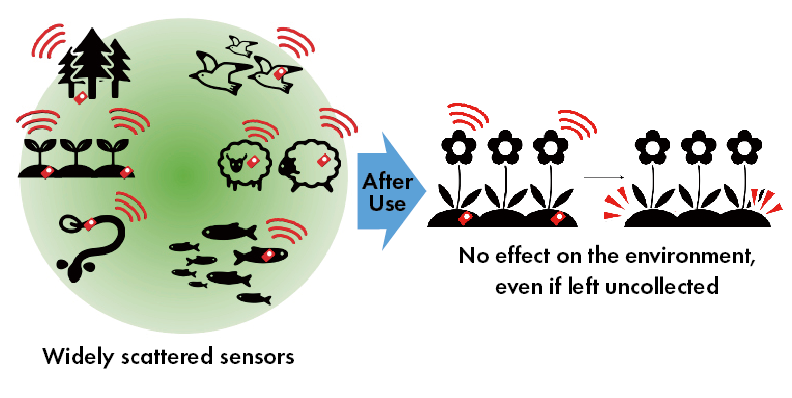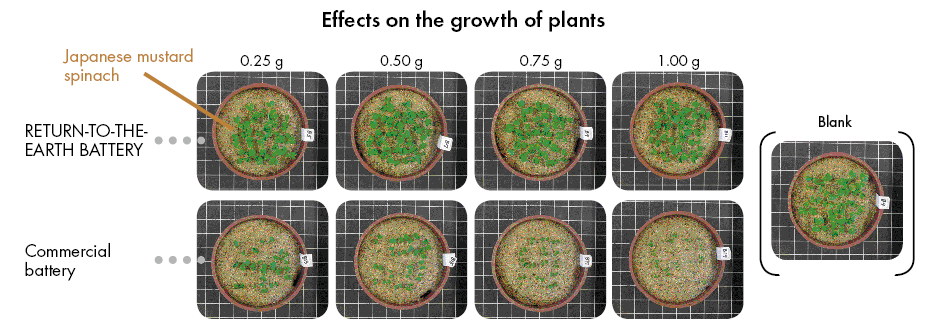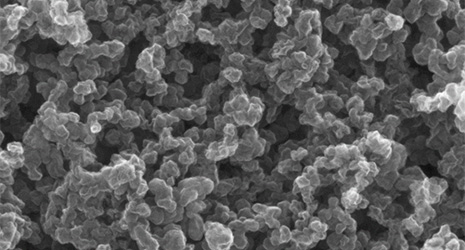
Sample of the RETURN-TO-THE-EARTH BATTERY (length c. 25 mm)
June 2020
The Battery That Returns to Earth

A Japanese telecommunications company has developed an all-purpose battery for environmental monitoring devices which has no impact on living organisms when abandoned in nature.
The Internet of things (IoT), in which various electronic devices embedded in social infrastructure, industrial systems and the natural environment connect over networks without human interaction, is making our lives more convenient and safe. In Japan, for example, wireless sensors have been widely installed in mountainous and hilly areas so that potential landslides from typhoons and heavy rain can be monitored remotely on a screen rather than in situ. Bio-logging, in which wild animals are tagged with sensors for tracking and conservation purposes, is another example of IoT use in the natural environment.
However, as this age of a trillion sensors has arrived, concerns over their impact on the natural environment have arisen since the batteries found in small sensors and other materials that make up the circuitry have a limited lifespan or utility and it is not possible to retrieve or recycle them all.
To address this problem, Nippon Telegraph and Telephone Corporation (NTT) has developed a battery that has no impact on soil or living organisms when abandoned in nature.
NTT announced the development of the RETURN-TO-THE-EARTH BATTERY in February of 2018 and has been working to improve its performance ever since. The environment-friendly RTTE battery is capable of generating cell voltage of 1.1 V at a measured current of 1.9 mA/cm2, sufficient when placed in series to enable signal transmission from a temperature sensor module. Further, tests based on the Fertilizer Certification Act have been performed, confirming that unlike conventional batteries, the RTTE battery does not adversely affect the growth of plants.
Researcher Nohara Masaya at the NTT Device Technology Laboratories says, “It is estimated that an increasingly large amount of sensors will be scattered around the natural world in the future as we aim for the realization of the IoT society. However, we cannot collect and reuse all of those sensors. For example, it is not possible to collect all of the sensors that were attached to migratory birds in the search for the path of infection of the avian influenza. The purpose of developing the [RTTE] battery was to keep these batteries, which could not be collected, from negatively impacting the natural environment.”
Conventional dry-cell batteries are typically composed of zinc alloy anodes, manganese dioxide cathodes, and a strongly alkaline electrolyte. NTT Device Technology Laboratories replaced these components with fertilizer ingredients for the anodes and electrolyte, and plant-based carbon for the cathodes.
According to Nohara, the biggest struggle in development was with the materials for the cathodes. With conventional technology, fluorine-based resin and other binding agents are used to solidify powdered carbon, but these binding agents are not found in soil and they can release toxic gas upon combustion. Because of this, a special pretreatment was applied to biological materials, solving the problem through developing electrodes that don’t use binding agents and leading to success in the development of a small, environment-friendly battery.
“In my department, we originally developed highly functional rechargeable batteries for cell phones,” Nohara explains. “We took many technologies and our knowledge from that work and applied it to environment-friendly batteries.”
NTT has worked on the development of semiconductors and circuitry for communications over many years, and has carried out research on other sensors and devices that can return to the earth besides the RTTE battery. There are high expectations for the realization of an IoT society that is also concerned with reducing its impact on the natural environment, in particular given the expected rapid increase in use of widely scattered sensors for natural disaster mitigation measures.






